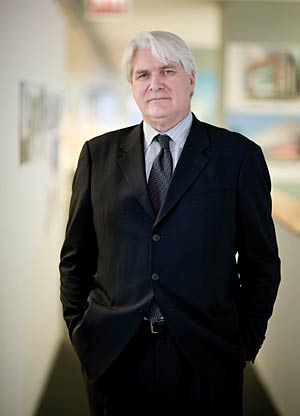Architects discuss strategies for staying alive.
John Lahey, AIA, chairman and principal in charge of design at Solomon Cordwell Buenz (SCB), in Chicago, says that after having been through the recessions of the 1980s and 1990s, he finds it better to lay off architects than offer a four-day work week. “People who are raring to go don’t like working four days a week,” he says. When SCB, known for its privately sponsored residential construction, was affected, “We reduced the staff, even though painful, ” says Lahey. Its head count now totals 130 after losing between 25 to 30 people to layoffs.

John Lahey of Solomon Cordwell Buenz, Chicago
'I'm an optimist, but I'm not crazy. This is going to be stressful. But you have time to make new relationships and do research.'
Where the jobs are
Like other architects, SCB is turning in new directions for work: “We decided a year and a half ago we would look for planning jobs in the Middle East,” says Lahey. Currently, his office has a master plan for Abu Dhabi Capital City on the boards, and closer to these shores, another one for Bratislava, Slovakia. Large-scale projects in the Middle East and Asia have long attracted other firms as well. In Johnson Fain’s case, William Fain is director of urban design and planning, while Scott Johnson is director of design. Accordingly, the firm has lined up urban projects in Beijing and Shanghai, among others, to supplement its architecture work, such as the renovation and expansion of the Dodger Stadium in Los Angeles and the American Indian Culture Center and Museum in Oklahoma City (with Hornbeek Blatt Architects and Hargreaves Associates).
While Perkins Eastman has been carrying out urban-planning studies in China and is doing a master plan for Hanoi, Brad Perkins notices that work there and in Korea and Japan is slowing down. Viable markets, he notes, are still found in India, and in some parts of the Middle East, such as Abu Dhabi, Qatar, and Saudi Arabia. Jaquelin Robertson, FAIA, partner of Cooper Robertson, a New York firm with a long-standing reputation for master planning, agrees that while Dubai seems to be in trouble, “Abu Dhabi is looking interesting, and Qatar still has money, so it’s awash with foreigners.”
No matter how hopeful these architects are about work in far-flung places, they know that what seems promising today could dry up tomorrow. In the mid-1970s recession, at least, big firms looked to the OPEC countries of the Middle East. Robertson, who spearheaded the master plan for Shahestan Palavi, the new center of Tehran, while working for the firm of Llewellyn-Davies, found it a terrific experience. “Shahestan used sustainable design principles, including solar power and wind chimneys,” he says. “We learned from vernacular low-rise buildings that responded to the climate, and saw what we were doing wrong at home.” Architects also encountered different political and cultural mind-sets, some of which were disturbingly unexpected. Gruzen and Samton, who had commissions in the Middle East, also have fond memories of the vodka and caviar served at the architects’ favorite gathering spot, the Tehran Hilton. But they found that getting paid could be dicey at the end. “When the Shah of Iran was ousted in 1979, we were doing a new town for Bell Helicopter,” says Samton. “We were worried about money, so two partners hung outside the office of the general in charge of the project. We got the check, which cleared two days before the Shah’s banks were closed and he went off to Egypt. Then the general was executed.”
Adjustments in approach
Volatile governments and different cultures can make working at home all the more tempting. Sohl says that the DeStefano office is investigating requests for qualifications for smaller jobs in the U.S. than it had previously looked for. He and his partners try to meet with people who don’t automatically know the firm. “Marketing is one activity that hasn’t slowed down,” he adds.
Nevertheless, architects are cutting back on traveling business class to seek work, among other lifestyle measures. “Lunches with partners are now box lunches,” says Buford. And the Stern office trimmed its 700-person Christmas party list by almost 30 percent this past December. Architects are not signing up for high-priced events and conferences with the same alacrity, though many are still keeping up memberships in professional organizations, such as the American Institute of Architects. “The AIA is very important now in helping us to figure out what to do,” says Gruzen.
And then, of course, there is the federally sponsored stimulus package. Generally, the feeling is that it will be a while before architects feel its benefits. As Bartle puts it, “If the money goes to the state, presumably it will take 16 months to two years to get a commission. Then, when you win it, you wait six months before the project gets going. So this looks grim.”
Back in the 1970s, a whole slew of architects drew, wrote, and taught, but didn’t build. As Diana Agrest, FAIA, of the New York firm Agrest Gandelsonas, puts it, “The recession is not so bad for the brain.” Agrest is currently producing and directing a documentary on Peter Eisenman, FAIA’s legendary Institute for Architecture and Urban Studies (IAUS), which thrived as an intellectual force in those years. Agrest, who was a fellow of the IAUS, remembers the high-octane professionals who had time to attend its lectures and symposia for “more reflection, less consumption.”
Now Sohl says that the DeStefano office has told its architects, if they want to take a leave to travel or study for a couple of months, the firm could accommodate them. Lahey of SCB concurs: “This is a stressful time. But it’s also the time to do research. Each recession you feel you are never going to build again, and then….”



Post a comment to this article
Report Abusive Comment